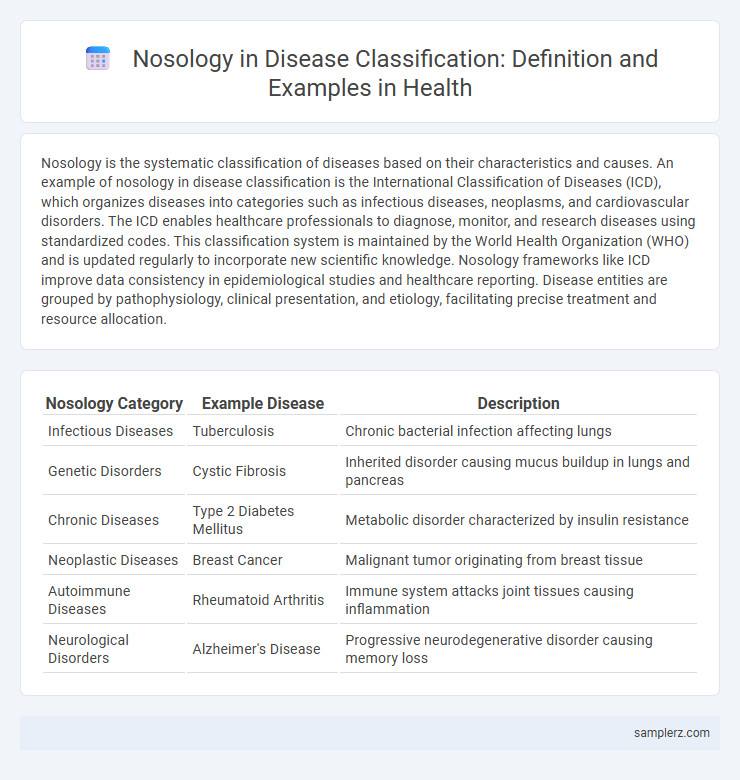Nosology is the systematic classification of diseases based on their characteristics and causes. An example of nosology in disease classification is the International Classification of Diseases (ICD), which organizes diseases into categories such as infectious diseases, neoplasms, and cardiovascular disorders. The ICD enables healthcare professionals to diagnose, monitor, and research diseases using standardized codes. This classification system is maintained by the World Health Organization (WHO) and is updated regularly to incorporate new scientific knowledge. Nosology frameworks like ICD improve data consistency in epidemiological studies and healthcare reporting. Disease entities are grouped by pathophysiology, clinical presentation, and etiology, facilitating precise treatment and resource allocation.
Table of Comparison
| Nosology Category | Example Disease | Description |
|---|---|---|
| Infectious Diseases | Tuberculosis | Chronic bacterial infection affecting lungs |
| Genetic Disorders | Cystic Fibrosis | Inherited disorder causing mucus buildup in lungs and pancreas |
| Chronic Diseases | Type 2 Diabetes Mellitus | Metabolic disorder characterized by insulin resistance |
| Neoplastic Diseases | Breast Cancer | Malignant tumor originating from breast tissue |
| Autoimmune Diseases | Rheumatoid Arthritis | Immune system attacks joint tissues causing inflammation |
| Neurological Disorders | Alzheimer's Disease | Progressive neurodegenerative disorder causing memory loss |
Introduction to Nosology in Disease Classification
Nosology, the systematic classification of diseases, plays a crucial role in medical diagnostics and epidemiology. It organizes diseases based on shared characteristics, such as etiology, pathology, and clinical manifestations, facilitating accurate diagnosis and treatment plans. For example, the International Classification of Diseases (ICD) serves as a standardized nosological framework widely used by healthcare professionals worldwide.
Historical Evolution of Nosology Systems
The historical evolution of nosology systems highlights pivotal frameworks such as the International Classification of Diseases (ICD) developed by the World Health Organization, which has undergone multiple revisions since its inception in the late 19th century. Early nosological efforts by Hippocrates and later Carl Linnaeus laid the groundwork for categorizing diseases based on symptoms and etiology, influencing modern diagnostic criteria. Advances in genetics and molecular biology continue to refine nosology by enabling classification systems that incorporate pathogenetic mechanisms alongside clinical manifestations.
Key Criteria for Disease Classification
Nosology in disease classification relies on key criteria such as etiology, pathogenesis, and clinical manifestation to accurately categorize diseases. These criteria help differentiate diseases based on their causes, mechanisms, and symptomatology, enabling targeted diagnosis and treatment. Utilizing standardized nosological frameworks like the ICD ensures consistent disease identification across medical practices and research.
ICD: The International Standard for Nosology
The International Classification of Diseases (ICD) serves as the global standard for nosology, systematically categorizing diseases and health conditions using alphanumeric codes. Its detailed taxonomy enables consistent recording, reporting, and analysis of morbidity and mortality worldwide. Widely implemented by healthcare providers and researchers, the ICD facilitates enhanced epidemiological surveillance and healthcare management.
Example: Nosology of Infectious Diseases
Nosology of infectious diseases classifies illnesses based on causative agents such as bacteria, viruses, fungi, and parasites. Examples include bacterial infections like tuberculosis, viral diseases such as influenza, fungal infections like candidiasis, and parasitic conditions including malaria. This classification aids in accurate diagnosis, targeted treatment, and effective epidemiological tracking of infectious diseases.
Example: Nosology of Genetic Disorders
Genetic disorders are classified in nosology based on inheritance patterns, such as autosomal dominant, autosomal recessive, and X-linked disorders, facilitating precise diagnosis and treatment planning. Examples include cystic fibrosis, categorized as an autosomal recessive disorder, and Huntington's disease, identified as autosomal dominant. This systematic classification aids in understanding disease etiology and guiding genetic counseling.
Nosology in Mental Health Disorders
Nosology in mental health disorders categorizes conditions such as schizophrenia, bipolar disorder, and major depressive disorder based on symptomatology, etiology, and prognosis. The Diagnostic and Statistical Manual of Mental Disorders (DSM-5) serves as a primary tool for this classification, enabling standardized diagnosis and treatment approaches. Accurate nosological classification improves clinical communication and facilitates research on mental health disease mechanisms and interventions.
Role of Nosology in Rare Disease Identification
Nosology plays a critical role in rare disease identification by providing a structured classification system that enables precise categorization of rare conditions based on clinical features, genetic markers, and pathology. This systematic approach facilitates early diagnosis, improves patient management, and supports research efforts by harmonizing disease terminology across medical databases and registries. Enhanced nosological frameworks contribute to increasing diagnostic accuracy and fostering the development of targeted therapies for rare diseases.
Challenges in Modern Nosology
Modern nosology faces challenges such as the complexity of multifactorial diseases like diabetes mellitus and cancer, where overlapping symptoms and genetic variability complicate clear categorization. Advances in molecular biology reveal subtypes within traditional disease categories, demanding updated classification systems that integrate genomic, proteomic, and phenotypic data. The evolving understanding of disorders such as neurodegenerative diseases requires nosology to adapt continuously for improved diagnosis and personalized treatment approaches.
Future Directions in Disease Classification Systems
Advancements in genomics and artificial intelligence are driving the future directions in disease classification systems, enabling more precise nosology based on molecular and genetic markers. Integrating multi-omics data enhances the ability to categorize diseases beyond traditional symptomatology, fostering personalized medicine approaches. Ongoing research focuses on developing dynamic, data-driven frameworks that adapt to new scientific discoveries, improving diagnosis and treatment outcomes.

example of nosology in disease classification Infographic
 samplerz.com
samplerz.com